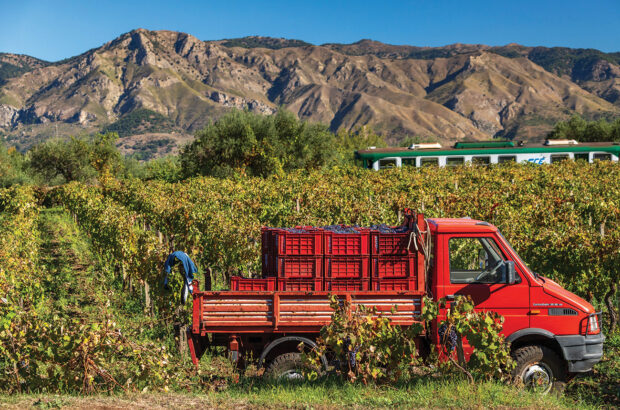Why bother ageing Burgundy when it is so good right out of the gate? Red Burgundy differs from other great wines of the world, such as Bordeaux, Hermitage, or Barolo, in that it is seductive almost from the minute it is bottled.
This is largely because the level of tannin in Pinot Noir is lower than that of Cabernet Sauvignon, Syrah or Nebbiolo. This supple texture makes it approachable at an earlier age.
Scroll down for tasting notes and scores for 20 mature Burgundy wines spanning the 1960s, 70s and 80s
With this texture and the perfumed, aromatic fruit character of Burgundy, the wines are almost sinfully delicious in their youth. For some wine lovers, however, drinking mature Burgundy is a quest akin to the search for the holy grail.
The fruit character of young red Burgundy is best described as red and black berries, cherries and plums. As the wines age, they gradually move from fresh fruit to baked fruit – think of cherry pie instead of fresh cherries. In the next stage, dried fruit components begin to arrive, with their suggestion of Christmas pudding.
An intriguing evolution
{"content":"PHA+RGV2ZWxvcG1lbnQsIGhvd2V2ZXIsIGNvbnNpc3RzIG5vdCBvbmx5IG9mIGEgY2hhbmdlIGluIHRoZSBmcnVpdCBjaGFyYWN0ZXIuIE1vcmUgY29tcG9uZW50cyBhcmUgYWRkZWQgYnkgdGhlIGZsb3JhbCBub3RlcyB0aGF0IGJlZ2luIGFzIHZpb2xldHMgb3Igcm9zZSBwZXRhbHMgb3IgbGF2ZW5kZXIgYW5kIHRoZW4gdHJhbnNmb3JtIGludG8gd2lsZCBoZXJicyBhbmQgY2lnYXIgbGVhZi48L3A+CjxwPjxkaXYgY2xhc3M9ImFkLWNvbnRhaW5lciBhZC1jb250YWluZXItLW1vYmlsZSI+PGRpdiBpZD0icG9zdC1pbmxpbmUtMiIgY2xhc3M9ImlwYy1hZHZlcnQiPjwvZGl2PjwvZGl2PjwvcD4KPHA+Q2FzayBhcm9tYXMgc3RhcnQgYXMgYSBzd2VldCBiYWtpbmcgc3BpY2UgYW5kIGNoYW5nZSB3aXRoIHRpbWUgdG8gc21va2UsIGNlZGFyIGFuZCBldWNhbHlwdHVzLiBQZXJoYXBzIHRoZSBtb3N0IGludHJpZ3VpbmcgZXZvbHV0aW9uIGlzIHRoZSBjaGFuZ2UgaW4gdGhlIGVhcnRoIGFuZCBtaW5lcmFsIG5vdGVzIHRvIHNvbWV0aGluZyBzYXZvdXJ5IGFuZCBhbG1vc3QgZ2FtZXksIGxpa2Ugcm9hc3QgbGFtYiBvciBwaWdlb24uPC9wPgo8cD5BcyB0aGUgYXJvbWFzIGNoYW5nZSwgdGhlIGltcHJlc3Npb24gb24gdGhlIHBhbGF0ZSBjaGFuZ2VzIHRvby4gVGFubmlucyBiZWdpbiB0byBzb2Z0ZW4sIGFuZCB0aGUgd2luZSBncm93cyByaWNoZXIgYW5kIGRlbnNlci4gSXQgYWxtb3N0IHNlZW1zIHN3ZWV0ZXIsIGFuZCB0aGUgYWNpZGl0eSBhcHBlYXJzIHRvIHNvZnRlbi4gT2YgY291cnNlLCB0aGUgd2luZSBkb2VzIG5vdCBpbmNyZWFzZSBpbiByZXNpZHVhbCBzdWdhciBvciBkZWNyZWFzZSBpbiBhY2lkaXR5LCBidXQgdGhlIGltcHJlc3Npb24gb2Ygc3dlZXRuZXNzIGlzIGVuaGFuY2VkIGFzIHRoZSBhcm9tYXMgbWF0dXJlIGFuZCB0aGUgdGFubmlucyBzb2Z0ZW4uPC9wPgo8cD5XaGl0ZSBCdXJndW5keSBhbHNvIGNoYW5nZXMgZHJhbWF0aWNhbGx5IG92ZXIgdGltZS4gVGhlIGluaXRpYWwgZnJ1aXQgYXJvbWFzIG9mIGFwcGxlIGFuZCBwZWFyIGdvIHRocm91Z2ggYSBzaW1pbGFyIGV2b2x1dGlvbiB0byB0aGUgcmVkcyBhcyB0aGV5IGFyZSB0cmFuc2Zvcm1lZCBpbnRvIGFwcGxlIHBpZSBvciBwZWFyIHRhcnQ7IGVhcmx5IGFyb21hcyBvZiBsZW1vbiBhcmUgY2hhbmdlZCBpbnRvIGRyaWVkIG9yYW5nZSBwZWVsLjwvcD4KPGRpdiBjbGFzcz0iYWQtY29udGFpbmVyIGFkLWNvbnRhaW5lci0tbW9iaWxlIj48ZGl2IGlkPSJwb3N0LWlubGluZS0zIiBjbGFzcz0iaXBjLWFkdmVydCI+PC9kaXY+PC9kaXY+CjxwPkZyZXNoIGZsb3JhbCBub3RlcyBiZWNvbWUgZHJpZWQgZmxvd2VycyBhbmQgcGVyZnVtZSwgYW5kIHRoZSB3aW5lbWFraW5nIGFyb21hcyBvZiBvYWsgc3BpY2UsIGNyZWFtIGFuZCBidXR0ZXIgYmVjb21lIGZ1c2VkIGludG8gc29tZXRoaW5nIHRoYXQgY2FuIHRha2Ugb24gYW4gZXhvdGljIGVkZ2UgdGhhdCByZXNlbWJsZXMgY29jb251dCBtaWxrIGFuZCBzcGljZS48L3A+CjxwPlRoaXMgZXhvdGljIGVkZ2UgaXMgcGFydGljdWxhcmx5IHRydWUgd2hlbiB0aGVyZSBpcyBzb21lIGJvdHJ5dGlzLCB3aGljaCBhZGRzIGEgbm90ZSBvZiBzYWZmcm9uLiBUaGVzZSBjaGFuZ2VzIGFyZSBub3JtYWxseSBzZWVuIHNvbWV3aGVyZSBiZXR3ZWVuIDMwIGFuZCA0MCB5ZWFycyBvZiBhZ2UuIEJleW9uZCB0aGlzLCBib3RoIHJlZHMgYW5kIHdoaXRlcyBjYW4gdGFrZSBvbiBhZGRpdGlvbmFsIGNvbXBsZXhpdHkgdGhhdCBjYW4gYmUgdmFyaW91c2x5IHJlZmVycmVkIHRvIGFzIHRydWZmbGUgb3IgZm9yZXN0IGZsb29yIChvciB0aGUgRnJlbmNoIGVxdWl2YWxlbnQgb2YgdGhpcywgJiM4MjE2O3NvdXMgYm9pc+KAmSkuPC9wPgo8ZGl2IGNsYXNzPSJhZC1jb250YWluZXIgYWQtY29udGFpbmVyLS1tb2JpbGUiPjxkaXYgaWQ9InBvc3QtaW5saW5lLTQiIGNsYXNzPSJpcGMtYWR2ZXJ0Ij48L2Rpdj48L2Rpdj4KPHA+VGhpcyBmb3Jlc3QgZmxvb3IsIGhvd2V2ZXIsIHNob3VsZCBiZSBhIGNsZWFuIGFyb21hLCB3aXRob3V0IG11c3R5IG9yIGRhbmsgb3ZlcnRvbmVzLCByZXNlbWJsaW5nIGEgd2FsayBpbiB0aGUgd29vZHMgb24gYW4gYXV0dW1uIGRheS48L3A+CjxwPk9uZSBjYW4gdGVsbCB3aGVuIHRoZSBldm9sdXRpb24gaGFzIGdvbmUgdG9vIGZhciB3aGVuIHRoZSBmb3Jlc3QgZmxvb3IgYXJvbWEgaW4gcmVkIHdpbmUgaGFzIGJlY29tZSBzb3kgc2F1Y2Ugb3IgY2FyYW1lbCBpbiB3aGl0ZSB3aW5lLiBUaGVzZSBhcmUgc2lnbnMgb2Ygb3hpZGF0aW9uIHRoYXQgY2FuIHBvaW50IHRvIGNvcmsgZmFpbHVyZSBvciBwb29yIHN0b3JhZ2UuPC9wPgo8ZGl2IGNsYXNzPSJhZC1jb250YWluZXIgYWQtY29udGFpbmVyLS1tb2JpbGUiPjxkaXYgaWQ9InBvc3QtaW5saW5lLTUiIGNsYXNzPSJpcGMtYWR2ZXJ0Ij48L2Rpdj48L2Rpdj4KPGgzPkFnZWluZyBoYXphcmRzPC9oMz4KPHA+VGhlIHBvdGVudGlhbCBmb3IgZGV2ZWxvcGluZyBvZmYgYXJvbWFzIGlzIG9uZSBvZiB0aGUgaGF6YXJkcyBpbiB0aGUgaHVudCBmb3IgbWF0dXJlIHdpbmUuIFRoaXMgcmlzayBjYW4gZWFzaWx5IGRldGVyIG5ldyBjb2xsZWN0b3JzLCBidXQgb2Z0ZW4gaXQgdGFrZXMganVzdCBvbmUgbWFnaWNhbCBib3R0bGUgdG8gaW5zcGlyZSB0aGUgc2VhcmNoIGZvciBtb3JlLjwvcD4KPHA+VGhlIHNhZmVzdCB0eXBlIG9mIG9sZCBib3R0bGVzIGFyZSB0aG9zZSByZWxlYXNlZCBkaXJlY3RseSBmcm9tIHRoZSBjZWxsYXJzIG9mIGEgd2luZSBwcm9kdWNlciwgb2Z0ZW4ga25vd24gYXMg4oCYZXgtY2VsbGFyc+KAmSBzYWxlcy4gQWx0aG91Z2ggdGhlc2Ugd2luZXMgY2FuIHNlZW0gZXhwZW5zaXZlIG9uIHJlbGVhc2UsIHdpdGggdGhlIGV2b2x1dGlvbiBvZiB0aGUgbWFya2V0LCBpdCBpcyB2aXJ0dWFsbHkgY2VydGFpbiB0aGF0IGluIGEgZGVjYWRlIG9yIHNvIHRoZXkgd2lsbCBzZWVtIGNoZWFwIGF0IHR3aWNlIHRoZSBwcmljZS48L3A+CjxwPldoZW4gYnV5aW5nIG9sZCBib3R0bGVzIGZyb20gdGhlIGRvbWFpbmUsIHRoZXkgYXJlIG9mdGVuIHJlY29uZGl0aW9uZWQsIHNvIHRoZXkgaGF2ZSBiZWVuIHRvcHBlZCB1cCB3aXRoIHdpbmUgZnJvbSB0aGUgc2FtZSB2aW50YWdlLCByZWNvcmtlZCBhbmQgcmVsYWJlbGxlZC4gV2luZSB0cmVhdGVkIGluIHRoaXMgd2F5IGNhbiBiZSBzcGVjdGFjdWxhcmx5IGRlbGljaW91cywgZXZlbiBmcm9tIG1vZGVzdCBhcHBlbGxhdGlvbnMuPC9wPgo8aHI+CjxkaXYgY2xhc3M9ImJyZWFrb3V0IHBhbGV0dGUtYSBwYW5lbCBwYW5lbC1kZWZhdWx0Ij48ZGl2IGNsYXNzPSJwYW5lbC1ib2R5Ij48ZGl2IGNsYXNzPSdicmVha291dC1jb250ZW50Jz48L3A+CjxoMiBzdHlsZT0idGV4dC1hbGlnbjogY2VudGVyOyI+TWF0dXJlIEJ1cmd1bmR5IHZpbnRhZ2VzPC9oMj4KPGgyPjxzdHJvbmc+MTk2MHM8L3N0cm9uZz48L2gyPgo8cD48c3Ryb25nPlRvIHNlZWsgb3V0Ojwvc3Ryb25nPiAxOTYxLCAxOTYyLCAxOTY0LCAxOTY2LCAxOTY5PC9wPgo8cD5Tb21lIG9mIHRoZSB3aW5lcyBmcm9tIDE5NjEgYXJlIGRyeWluZyBvdXQgbm93IGFuZCBsYWNrIGNoYXJtLCBhbHRob3VnaCBKYWNreSBSaWdhdXggdGVsbHMgdXMgdGhhdCBpdCB3YXMgYSBmYXZvcml0ZSBvZiBIZW5yaSBKYXllciBhbmQgb3RoZXIgcHJvZHVjZXJzLiBCb3RoIDE5NjIgYW5kIDE5NjQgYXJlIHN1cGVyYiB2aW50YWdlcyBhbmQgdGhlIGJlc3Qgd2luZXMgYXJlIGRyaW5raW5nIHdlbGwgbm93LiAxOTY2IGlzIGp1c3QgYSBub3RjaCBkb3duIGZyb20gdGhlc2UgaW4gbXkgb3Bpbmlvbi4gU29tZSB0YXN0ZXJzIGRvIG5vdCBhcHByZWNpYXRlIHRoZSB3aW5lcyBmcm9tIDE5NjkgYXMgbXVjaCBhcyBJIGRvLCBidXQgSSBoYXZlIGJlZW4gY29uc2lzdGVudGx5IHdvbiBvdmVyLjwvcD4KPHA+PHN0cm9uZz5UbyBhdm9pZDo8L3N0cm9uZz4gMTk2MCwgMTk2MywgMTk2NSwgMTk2NywgMTk2ODwvcD4KPGhyPgo8aDI+PHN0cm9uZz4xOTcwczwvc3Ryb25nPjwvaDI+CjxwPjxzdHJvbmc+VG8gc2VlayBvdXQ6PC9zdHJvbmc+IDE5NzEsIDE5Nzg8L3A+CjxwPkJvdGggYXJlIHN1cGVyYiB5ZWFyczsgaW4gZ2VuZXJhbCwgMTk3OCBnZXRzIHRoZSBlZGdlIGFzIHRoZSBiZXR0ZXIgdmludGFnZSwgYWx0aG91Z2ggdGhhdCB3YXMgbm90IHRoZSBjYXNlIHVwb24gcmVsZWFzZS4gQm90aCBhcmUgY29uc2lkZXJlZCBiZXR0ZXIgZm9yIHJlZCB0aGFuIGZvciB3aGl0ZS48L3A+CjxwPjxzdHJvbmc+QXBwcm9hY2ggd2l0aCBjYXV0aW9uOjwvc3Ryb25nPiAxOTcyLCAxOTc2LCAxOTc5PC9wPgo8cD5Tb21lIHRhc3RlcnMgcHJhaXNlIHRoZSAxOTcyIHZpbnRhZ2UsIGJ1dCBteSBvd24gZXhwZXJpZW5jZSBoYXMgYmVlbiBtaXhlZCAoYnV0IHNlZSB0YXN0aW5nIG5vdGVzIGZvciBhbiBleGNlcHRpb24pLiAxOTc2IHdhcyBhIGhvdCB5ZWFyLCBhbmQgc29tZSBvZiB0aGUgd2luZXMgYXJlIHRhc3RpbmcgYSBiaXQgYmFrZWQsIGJ1dCB3aXRoIGx1Y2sgKGFuZCBnb29kIGNlbGxhcmluZyksIHRoZXkgY2FuIGJlIHN1cGVyYi4gVGhlcmUgd2FzIGhhaWwgaW4gMTk3OSBpbiBWb3NuZS1Sb21hbsOpZSwgYnV0IGVsc2V3aGVyZSB0aGUgdmluZXMgd2VyZSBzcGFyZWQ7IHRoZSB5ZWFyLCBpbiBnZW5lcmFsLCB3YXMgYmV0dGVyIGZvciB3aGl0ZSB3aW5lIHRoYW4gcmVkLjwvcD4KPHA+PHN0cm9uZz5UbyBhdm9pZDo8L3N0cm9uZz4gMTk3MCwgMTk3MyAoZXhjZXB0IGZvciB3aGl0ZXMpLCAxOTc0LCAxOTc1LCAxOTc3PC9wPgo8aDI+PHN0cm9uZz4xOTgwczwvc3Ryb25nPjwvaDI+CjxwPjxzdHJvbmc+VG8gc2VlayBvdXQ6PC9zdHJvbmc+IDE5ODUsIDE5ODk8L3A+CjxwPlRoZXNlIGFyZSBib3RoIHN1cGVyYiwgdG9wLW5vdGNoIHZpbnRhZ2VzLiBZaWVsZHMgd2VyZSBsb3cgaW4gMTk4NSwgd2hpY2ggZ2F2ZSB0aGUgd2luZXMgY29uY2VudHJhdGlvbi4gMTk4OSB3YXMgYSBob3QgdmludGFnZSwgYnV0IHRoZSBiZXN0IHdpbmVzIGFyZSBkZWxpcmlvdXNseSBnb29kLjwvcD4KPHA+PHN0cm9uZz5BcHByb2FjaCB3aXRoIGNhdXRpb246PC9zdHJvbmc+IDE5ODAsIDE5ODEsIDE5ODg8L3A+CjxwPkluaXRpYWxseSwgdGhlIHdpbmVzIGZyb20gMTk4MCB3ZXJlIGRpc21pc3NlZCBieSBjb2xsZWN0b3JzLiBNeSBleHBlcmllbmNlIGhhcyBiZWVuIGdvb2QsIGFuZCB0aGV5IGFyZSBnZW5lcmFsbHkgbW9yZSBhcHByZWNpYXRlZCBub3cuIFRoZSBvcHBvc2l0ZSBpcyByZWxhdGl2ZWx5IHRydWUgb2YgdGhlIHdpbmVzIGZyb20gMTk4MTogcHJhaXNlZCBlYXJseSwgSSBoYXZlIG5vdCBmb3VuZCB0aGF0IG1hbnkgSSBoYXZlIGxvdmVkLiBUaGUgZ2VuZXJhbCB0aG91Z2h0IG9uIHRoZSB3aW5lcyBvZiAxOTg4IGlzIHRoYXQgdGhleSBoYXZlIHRvbyBtdWNoIHRhbm5pbiBhbmQgYWNpZC4gTXkgb3duIGV4cGVyaWVuY2Ugb2YgdGhlbSBoYXMgYmVlbiBtdWNoIG1vcmUgcG9zaXRpdmUuPC9wPgo8cD48c3Ryb25nPlRvIGF2b2lkOjwvc3Ryb25nPiAxOTgyLCAxOTgzLCAxOTg0LCAxOTg2IChleGNlcHQgaW4gd2hpdGUpLCAxOTg3IDwvcD4KPC9kaXY+PGRpdiBjbGFzcz0nYnJlYWtvdXQtYnV0dG9ucyc+PGRpdiBjbGFzcz0ncm93Jz48L2Rpdj48L2Rpdj48L2Rpdj48L2Rpdj4KPGhyPgo8cD5UaGUgbmV4dCBjYXRlZ29yeSBvZiB3aW5lcyBhcmUgdGhvc2UgdGhhdCBoYXZlIG5ldmVyIGxlZnQgdGhlIHJlZ2lvbiBvZiBwcm9kdWN0aW9uLiBUaGVzZSBoYXZlIGVpdGhlciBjb21lIG91dCBvZiBwcml2YXRlIGNvbGxlY3Rpb25zIG9yIGZyb20gYSByZXN0YXVyYW50IGNlbGxhci4gQWRtaXR0ZWRseSwgZHJpbmtpbmcgdGhlc2Ugd2luZXMgcmVxdWlyZXMgdHJhdmVsaW5nLCBidXQgdGhpcyBzb3J0IG9mIHRyYXZlbCBpcyBmYXIgZnJvbSBvbmVyb3VzLjwvcD4KPHA+V2luZXMgYXJlIG9mdGVuIHN0b3JlZCBpbiBCdXJndW5keSBpbiBjb29sLCBodW1pZCBzdG9uZS4gVGhpcyB0eXBlIG9mIHN0b3JhZ2UgY2FuIGNhdXNlIHRoZSBsYWJlbHMgdG8gZGlzaW50ZWdyYXRlIHdpdGggZGFtcCBzdGFpbnMgYW5kIG1vbGQsIGJ1dCB0aGVzZSBhcmUgY29zbWV0aWMgY29uc2lkZXJhdGlvbnMsIGFuZCBtb3N0IG9mdGVuIHRoZSBjb25kaXRpb24gb2YgdGhlIHdpbmUgaXMgdW5hZmZlY3RlZC48L3A+CjxwPlRoZSB0d28gbW9zdCBpbXBvcnRhbnQgdGhpbmdzIHRvIGxvb2sgZm9yIHdoZW4gZXhhbWluaW5nIG9sZGVyIGJvdHRsZXMgb2Ygd2luZSBhcmUgdGhlIGZpbGwgKHRlY2huaWNhbGx5IGtub3duIGFzIHRoZSB1bGxhZ2UpIGFuZCB0aGUgY29sb3VyIG9mIHRoZSB3aW5lLiBUaGUgZmlsbCBpcyBtZWFzdXJlZCBpbiBjZW50aW1ldHJlcyBmcm9tIHRoZSBjb3JrLjwvcD4KPHA+Qm90dGxlcyB3aXRoIGEgaGVhZHNwYWNlIG9mIDIuNWNtIG9yIGxlc3MgYXJlIHNob3dpbmcgbGl0dGxlIGNoYW5nZSBmcm9tIGJvdHRsaW5nLiBPbGRlciBib3R0bGVzIHdpdGggMy41Y20gb3IgZXZlbiA0Y20gb2YgaGVhZHNwYWNlIGFyZSBvZnRlbiB3b25kZXJmdWwuIFNvbWV0aW1lcyBpZiB0aGUgYm90dGxlIGlzIHZlcnkgb2xkIChvciB2ZXJ5IHJhcmUsIG9yIHJlYXNvbmFibHkgcHJpY2VkKSBvbmUgbWlnaHQgdGFrZSBhIGNoYW5jZSBvbiBhbiBldmVuIGxvd2VyIGZpbGwsIHNheSA1Y20gb3IgNS41Y20sIGJ1dCB0aGVyZSBpcyBhIGJpdCBvZiByaXNrLjwvcD4KPHA+SXQmIzgyMTc7cyBlc3NlbnRpYWwgdG8gZXZhbHVhdGUgdGhlIGZpbGwgaW4gY29uanVuY3Rpb24gd2l0aCB0aGUgY29sb3VyLiBBIGxpZ2h0IGNvbG91ciBpcyBmaW5lLCBldmVuIGRlc2lyYWJsZSwgYnV0IGl0IHNob3VsZCBoYXZlIGFuIGF0dHJhY3RpdmUgZ2FybmV0IGNvbG91ciAoanVzdCBzaGlmdGluZyB0byBicmljayBkZXBlbmRpbmcgb24gYWdlKSwgYnV0IGl0IHNob3VsZCBpbiBubyBjaXJjdW1zdGFuY2VzIGJlIGNsb3VkeS4gVGhvc2Ugb24gYSBzZXJpb3VzIGh1bnQgZm9yIG9sZCB3aW5lIG1pZ2h0IGNvbnNpZGVyIGJyaW5naW5nIGEgc21hbGwgcnVsZXIgYW5kIGEgaGlnaC1wb3dlcmVkIExFRCBmbGFzaGxpZ2h0IHRvIGV4YW1pbmUgdGhlIHdpbmUuPC9wPgo8aDM+S25vdyB5b3VyIG1lcmNoYW50czwvaDM+CjxwPk9uY2UgeW914oCZdmUgbGVmdCB0aGUgc29tZXdoYXQgcmFyaWZpZWQgcmVhbG1zIG9mIGV4LWNlbGxhcnMgYW5kIGNhcmVmdWxseSBjZWxsYXJlZCBib3R0bGVzIGluIEJ1cmd1bmR5LCB0aGUgcmlzayBvZiBkaXNhcHBvaW50bWVudCBjYW4gaW5jcmVhc2UuIFRoZSBiZXN0IHNvbHV0aW9uIGlzIHRvIGtub3cgeW91ciBtZXJjaGFudHMuIElkZWFsbHksIHlvdSB3aWxsIGhhdmUgbWV0IGV2ZXJ5b25lIHlvdSBidXkgd2luZSBmcm9tLCBhbmQgdGhleSB3aWxsIGhhdmUgYmVlbiBpbiBidXNpbmVzcyBmb3IgbWFueSB5ZWFycy4gQWJvdmUgYWxsLCBkbyBub3QgYmUgdGVtcHRlZCBieSBsb3cgcHJpY2VzIGZyb20gdW5mYW1pbGlhciBtZXJjaGFudHMuIElmIGl0IHNvdW5kcyB0b28gZ29vZCB0byBiZSB0cnVlLCBpdCBvZnRlbiBpcy48L3A+CjxwPldoZW5ldmVyIHBvc3NpYmxlLCBpbnNwZWN0IGJvdHRsZXMgYmVmb3JlIHB1cmNoYXNlLiBBIHJlcHV0YWJsZSBtZXJjaGFudCB3aWxsIGhhcHBpbHkgc2VuZCBwaG90b2dyYXBocyBvZiBvbGRlciBib3R0bGVzIGlmIHlvdSBjYW5ub3QgZXhhbWluZSB0aGUgd2luZSBpbiBwZXJzb24uIEFub3RoZXIgdmFsdWFibGUgY29uc2lkZXJhdGlvbiBpcyB0aGF0IHdpbmUgYmVpbmcgc29sZCBpbiBpdHMgb3JpZ2luYWwgcGFja2FnaW5nICh0aGUgb3JpZ2luYWwgd29vZGVuIGNhc2Ugb3IgY2FydG9uKSBpcyBvZnRlbiBhIHNpZ24gb2YgY2FyZWZ1bCBjZWxsYXJpbmcuPC9wPgo8aDM+QXVjdGlvbiBsb3RzPC9oMz4KPHA+R2l2ZW4gbXkgcHJvZmVzc2lvbmFsIGV4cGVyaWVuY2UgYXQgQ2hyaXN0aWUmIzgyMTc7cywgSSBoYXZlIGEgcmVsYXRpdmVseSBoaWdoIGNvbWZvcnQgbGV2ZWwgb2YgYnV5aW5nIHdpbmUgYXQgYXVjdGlvbi4gU2ltaWxhciBydWxlcyBhcHBseTogZ2V0IHRvIGtub3cgb25lIG9mIHRoZSBzcGVjaWFsaXN0cyBhdCB5b3VyIGF1Y3Rpb24gaG91c2Ugb2YgY2hvaWNlIGFuZCBhc2sgdGhlbSBxdWVzdGlvbnMgYWJvdXQgYm90dGxlcyB0aGF0IGludGVyZXN0IHlvdSwgc3VjaCBhcyDigJh3aGF0IGNhbiB5b3UgdGVsbCBtZSBhYm91dCB0aGUgcHJvdmVuYW5jZSBhbmQgc3RvcmFnZSBvZiB0aGUgd2luZT\/igJk8L3A+CjxwPldpdGggcHJhY3RpY2UsIHlvdSB3aWxsIGFsc28gYmVjb21lIGFjY3VzdG9tZWQgdG8gc3R1ZHlpbmcgdGhlIG1ldGEtZGF0YSBvZiB0aGUgYXVjdGlvbiBjYXRhbG9ndWUuIFlvdSB3aWxsIG5vdGljZSB0aGF0IGVhY2ggc2VjdGlvbiBoYXMgYW4gaW50cm9kdWN0aW9uIG9yIGhlYWRlciB0aGF0IHdpbGwgaGVscCB5b3UgZ2xlYW4gc29tZSBpbmZvcm1hdGlvbiBhYm91dCB0aGUgY29uc2lnbm1lbnQuPC9wPgo8cD5UaGUgYmVzdCBjb25zaWdubWVudHMgYXJlIG5hbWVkLCBwYXJ0aWN1bGFybHkgdGhvc2UgZnJvbSBhIG5vdGVkIGNvbGxlY3Rvci4gVGhlc2Ugb2Z0ZW4gY29tbWFuZCBhIHByZW1pdW0uIEl0IGlzIGFsc28gcG9zc2libGUgdG8gZ2V0IGEgc2Vuc2Ugb2YgYSBjb2xsZWN0aW9uIGZyb20gd2hhdCBlbHNlIGlzIGJlaW5nIG9mZmVyZWQgZnJvbSB0aGUgc2FtZSB2ZW5kb3IuIEFyZSBjb25kaXRpb25zIGdlbmVyYWxseSBnb29kPyBBcmUgdGhlcmUganVzdCBvbmUgb3IgdHdvIG9sZGVyIGJvdHRsZXMsIG9yIGlzIHRoaXMgZnJvbSBzb21lb25lIHBhc3Npb25hdGUgYWJvdXQgb2xkZXIgd2luZXM\/IEFib3ZlIGFsbCwgcmVtZW1iZXIgdG8gYXZvaWQgdGhlICYjODIxNjt1bmljb3JucyYjODIxNzssIHRoZSB1YmVyLXJhcmUgJiM4MjE2O2JvdHRsZXMgb2YgYSBsaWZldGltZSYjODIxNzssIHdoaWNoIGdlbmVyYWxseSBmYWxsIGludG8gdGhlICYjODIxNjt0b28tZ29vZC10by1iZS10cnVlJiM4MjE3OyBjYXRlZ29yeS48L3A+CjxwPldpdGggYSBsb3Qgb2YgbG9va2luZyBhbmQgYSBiaXQgb2YgY2F1dGlvbiwgYW5kIGEgYml0IG9mIGx1Y2ssIGl0IGlzIHN0aWxsIHBvc3NpYmxlIHRvIHNvdXJjZSBleHRyYW9yZGluYXJ5IEJ1cmd1bmR5IHRoYXQgbWF5IGJlIHlvdXIgaG9seSBncmFpbC48L3A+Cjxocj4KPGgyPldoZXJlIHRvIGZpbmQgbWF0dXJlIEJ1cmd1bmR5PC9oMj4KPHA+V2hhdCBmb2xsb3dzIGFyZSBhIGZldyBleGFtcGxlcywgdmVyeSBmYXIgZnJvbSBhbiBleGhhdXN0aXZlIGxpc3QsIG9mIHdoZXJlIG9uZSBtaWdodCBmaW5kIGludGVyZXN0aW5nIGJvdHRsZXMgb2Ygb2xkIEJ1cmd1bmR5LjwvcD4KPHA+PHN0cm9uZz5NZXJjaGFudHMgKEZyYW5jZSk8L3N0cm9uZz48L3A+CjxwPlBsYWNlIGRlcyBHcmFuZHMgQ3J1czxiciAvPgoyMCBQbGFjZSBDYXJub3Q8YnIgLz4KMjEyMDAgQmVhdW5lLCBGcmFuY2U8YnIgLz4KKzMzIDMgODAgMjIgNjIgODk8L3A+CjxwPk1vbiBNaWxsw6lzaW1lPGJyIC8+CjU0IFJ1ZSBkdSBGYXVib3VyZyBNYWRlbGVpbmU8YnIgLz4KMjEyMDAgQmVhdW5lLCBGcmFuY2U8YnIgLz4KKzMzIDMgODAgMjIgOTIgNzE8L3A+CjxwPkNhdmVhdSBkZSBDaGFzc2FnbmU8YnIgLz4KNyBSdWUgQ2hhcmxlcyBQYXF1ZWxpbjxiciAvPgoyMTE5MCBDaGFzc2FnbmUtTW9udHJhY2hldDxiciAvPgorMzMgMyA4MCAyMSAzOCAxMzwvcD4KPHA+PHN0cm9uZz5NZXJjaGFudHMgKExvbmRvbik8L3N0cm9uZz48L3A+CjxwPkhlZG9uaXNtIFdpbmVzPGJyIC8+CjMtNyBEYXZpZXMgU3Q8YnIgLz4KTG9uZG9uIFcxSyAzTEQ8YnIgLz4KKzQ0IDIwIDcyOTAgNzg3MDwvcD4KPHA+QmVycnkgQnJvcy4gJmFtcDsgUnVkZDxiciAvPgo2MyBQYWxsIE1hbGwsIFN0LiBKYW1lcyYjODIxNztzPGJyIC8+CkxvbmRvbiBTVzFZIDVIWjxiciAvPgpEb27igJl0IGZvcmdldCB0byBjaGVjayB0aGVpciBicm9raW5nIHNlcnZpY2UgQkJYIGZvciBvbGRlciB2aW50YWdlczwvcD4KPHA+SnVzdGVyaW5pICZhbXA7IEJyb29rcyBMdGQ8YnIgLz4KNjEgU3QgSmFtZXMmIzgyMTc7cyBTdCwgU3QuIEphbWVzJiM4MjE3O3M8YnIgLz4KTG9uZG9uIFNXMUEgMUxaPGJyIC8+Cis0NCAyMCA3NDg0IDY0MzA8YnIgLz4KSnVzdGVyaW5p4oCZcyBhbHNvIG1haW50YWlucyBhIGJyb2tpbmcgc2VydmljZSBmb3Igb2xkZXIgd2luZXM8L3A+CjxwPjxzdHJvbmc+TWVyY2hhbnRzIChBc2lhKTwvc3Ryb25nPjwvcD4KPHA+VGhlIEZpbmUgV2luZSBFeHBlcmllbmNlPGJyIC8+ClNob3AgQSwgMTY1LTE2NiBDb25uYXVnaHQgUm9hZCBXZXN0IChFbnRyYW5jZSBvbiBDaGl1IEt3b25nIFN0cmVldCk8YnIgLz4KU2FpIFlpbmcgUHVuLCBIb25nIEtvbmc8YnIgLz4KKzg1MiAyODAzLTA3NTMgLyA5NzAyLTk2NTQ8L3A+CjxwPkdpbnNiZXJnK0NoYW4gV2luZSBNZXJjaGFudHMgQXNpYTxiciAvPgo2dGggRmxvb3IsIExva2UgWWV3IEJ1aWxkaW5nPGJyIC8+CjUwLTUyIFF1ZWVuJiM4MjE3O3MgUm9hZCBDZW50cmFsPGJyIC8+CkhvbmcgS29uZzxiciAvPgorODUyIDI1MDQtMjIyMTwvcD4KPGhyPgo8cD48c3Ryb25nPkF1Y3Rpb24gaG91c2VzPC9zdHJvbmc+PC9wPgo8cD5UaGUgcHJpbWFyeSBpbnRlcm5hdGlvbmFsIGF1Y3Rpb24gaG91c2VzIGluY2x1ZGUgdGhlIHN0b3JpZWQgZ2VuZXJhbGlzdHMgPHN0cm9uZz48YSBocmVmPSJodHRwczovL3d3dy5jaHJpc3RpZXMuY29tLyI+Q2hyaXN0aWXigJlzPC9hPjwvc3Ryb25nPiwgPHN0cm9uZz48YSBocmVmPSJodHRwczovL3d3dy5zb3RoZWJ5cy5jb20vIj5Tb3RoZWJ54oCZczwvYT48L3N0cm9uZz4sIGFuZCA8c3Ryb25nPjxhIGhyZWY9Imh0dHBzOi8vd3d3LmJvbmhhbXMuY29tLyI+Qm9uaGFt4oCZczwvYT4gPC9zdHJvbmc+YW5kIFVTLWJhc2VkIHdpbmUtb25seSBzcGVjaWFsaXN0cyA8c3Ryb25nPjxhIGhyZWY9Imh0dHBzOi8vd3d3LmFja2Vyd2luZXMuY29tLyI+QWNrZXI8L2E+PC9zdHJvbmc+LCA8c3Ryb25nPjxhIGhyZWY9Imh0dHBzOi8vd3d3LnphY2h5cy5jb20vIj5aYWNoeXM8L2E+PC9zdHJvbmc+LCBhbmQgPHN0cm9uZz48YSBocmVmPSJodHRwczovL2F1Y3Rpb24uaGRod2luZS5jb20vIj5IYXJ0LCBEYXZpcywgSGFydCAoSERIKTwvYT48L3N0cm9uZz4uIEFsbCBoYXZlIHNldmVyYWwgb2ZmaWNlcy48L3A+Cjxocj4KPHA+PHN0cm9uZz5SZXN0YXVyYW50czwvc3Ryb25nPjwvcD4KPHA+UmVzdGF1cmFudHMgYXJlIG9mdGVuIGdyZWF0IHBsYWNlcyB0byBmaW5kIG9sZCBib3R0bGVzLiBUaGV5IG9mdGVuIGVuam95IGdlbmVyb3VzIGFsbG9jYXRpb25zLCBwYXJ0aWN1bGFybHkgd2hlbiB0aGV5IGNvbnRlbnQgdGhlbXNlbHZlcyB3aXRoIG1vZGVzdCBtYXJrLXVwczogd2luZW1ha2VycyBsb3ZlIHRvIGtub3cgdGhhdCB0aGVpciB3aW5lcyBhcmUgYmVpbmcgZHJ1bmsgYnkgYWZpY2lvbmFkb3Mgd2hvIGVuam95IHRoZW0gcmF0aGVyIHRoYW4gYmVpbmcgdGhlIG9iamVjdHMgb2Ygc3BlY3VsYXRpb24uPC9wPgo8cD48c3Ryb25nPkluIEZyYW5jZTwvc3Ryb25nPjwvcD4KPHA+TWFpc29uIExhbWVsb2lzZTxiciAvPgozNiBQbC4gZCYjODIxNztBcm1lczxiciAvPgo3MTE1MCBDaGFnbnksIEZyYW5jZTxiciAvPgorMzMgMyA4NSA4NyA2NSA2NTwvcD4KPHA+SG9zdGVsbGVyaWUgZGUgTGV2ZXJub2lzPGJyIC8+ClJ1ZSBkdSBHb2xmPGJyIC8+CjIxMjAwIExldmVybm9pcywgRnJhbmNlPGJyIC8+CiszMyAzIDgwIDI0IDczIDU4PC9wPgo8cD5NYSBDdWlzaW5lPGJyIC8+ClBhc3NhZ2UgU2FpbnQtSMOpbMOobmU8YnIgLz4KMjEyMDAgQmVhdW5lLCBGcmFuY2U8YnIgLz4KKzMzIDMgODAgMjIgMzAgMjI8L3A+CjxwPkxlIEJpc3RybyBkZSBMJiM4MjE3O0jDtHRlbDxiciAvPgozIFJ1ZSBTYW11ZWwgTGVnYXk8YnIgLz4KMjEyMDAgQmVhdW5lLCBGcmFuY2U8YnIgLz4KKzMzIDMgODAgMjUgOTQgMTA8L3A+CjxwPkxlIENvbnR5PGJyIC8+CjUgUnVlIEbDqWxpeCBaaWVtPGJyIC8+CjIxMjAwIEJlYXVuZTxiciAvPgorMzMgMyA4MCAyMiA2MyA5NDwvcD4KPGRpdiBjbGFzcz0iaW5qZWN0aW9uIj48L2Rpdj4KPHA+U3BlY2lhbCBtZW50aW9uIHNob3VsZCBiZSBtYWRlIG9mIEZyYW7Dp29pcyBBdWRvdXplLCBhIGNvbGxlY3RvciBiYXNlZCBpbiBQYXJpcyB3aG8gb3JnYW5pemVzIGRpbm5lcnMgd2l0aCBvbGQgd2luZXMgYXQgdmFyaW91cyBsb2NhdGlvbnMuIFlvdSB3aWxsIGZpbmQgPHN0cm9uZz48YSBocmVmPSJodHRwOi8vd3d3LmFjYWRlbWllZGVzdmluc2FuY2llbnMub3JnLyI+aGlzIGJsb2cgd2l0aCBhbGwgYXBwcm9wcmlhdGUgZGV0YWlscyBoZXJlPC9hPjwvc3Ryb25nPi48L3A+CjxwPjxzdHJvbmc+T3V0c2lkZSBvZiBGcmFuY2U8L3N0cm9uZz48L3A+CjxwPlBhbGFpcyBDb2J1cmc8YnIgLz4KQ29idXJnYmFzdGVpIDQ8YnIgLz4KMTAxMCBXaWVuLCBBdXN0cmlhPGJyIC8+Cis0MyAxIDUxODE4MDwvcD4KPHA+Q2hhdC1Cb3R0w6k8YnIgLz4KUXVhaSBkdSBNb250LUJsYW5jIDEzPGJyIC8+CjEyMDEgR2Vuw6h2ZSwgU3dpdHplcmxhbmQ8YnIgLz4KKzQxIDIyIDcxNiA2OSAyMDwvcD4KPHA+QmVybiYjODIxNztzIFN0ZWFrIEhvdXNlPGJyIC8+CjEyMDggUyBIb3dhcmQgQXZlPGJyIC8+ClRhbXBhLCBGTCAzMzYwNjxiciAvPgorMSAoODEzKSAyNTEtMjQyMTwvcD4KPHA+Cg=="}
Mature Burgundy: 20 wines to seek out from the 1960s, 70s and 80s
The wines are listed oldest to youngest
{}
{"wineId":"58379","displayCase":"standard","paywall":true}
{"wineId":"58378","displayCase":"standard","paywall":true}
{"wineId":"58374","displayCase":"standard","paywall":true}
{"wineId":"58361","displayCase":"standard","paywall":true}
{"wineId":"58377","displayCase":"standard","paywall":true}
{"wineId":"58376","displayCase":"standard","paywall":true}
{"wineId":"58371","displayCase":"standard","paywall":true}
{"wineId":"58364","displayCase":"standard","paywall":true}
{"wineId":"58367","displayCase":"standard","paywall":true}
{"wineId":"58363","displayCase":"standard","paywall":true}
{"wineId":"58372","displayCase":"standard","paywall":true}
{"wineId":"58365","displayCase":"standard","paywall":true}
{"wineId":"58373","displayCase":"standard","paywall":true}
{"wineId":"58368","displayCase":"standard","paywall":true}
{"wineId":"58375","displayCase":"standard","paywall":true}
{"wineId":"58362","displayCase":"standard","paywall":true}
{"wineId":"58369","displayCase":"standard","paywall":true}
{"wineId":"58366","displayCase":"standard","paywall":true}
{"wineId":"58370","displayCase":"standard","paywall":true}
{"wineId":"47902","displayCase":"standard","paywall":true}
{}
Related articles












